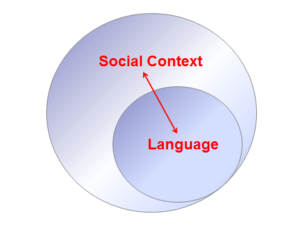Language, Winnie-the-Pooh, and how linguistics can help you

Effective communication is vital for success in so many areas of life – graduating from university, getting a job, buying a pair of shoes, making friends. So, to ensure the path to success is visible to our students, we need to shine a light on the language choices that good communicators make and the reasons they make them.
And the best way to do this is to fully understand language and the intricacies of successful communication – a process that begins by looking at language through the lens of theories which can help us articulate what we find there.
Context as important as words
Language is essentially a tool used by people to communicate with each other. It’s a social phenomenon, a part of human society. Patterns of language use bind groups of people together and dictate the ideas and beliefs they value and the ways they can express their experiences of the world. Thus, when thinking about language, social context is as important as the structure of sentences; the system of signs that make up language have meaning not in their own right, but because they are embedded in society.

This fact lies at the heart of the theory of language founded by the linguist Michael Halliday: Systemic Functional Linguistics (commonly referred to as SFL).
Here’s a simple explanation of that rather complex-sounding name:
- Linguistics identifies SFL as a theory of language.
- Functional means it is primarily concerned with what language and its constituent parts actually do and how texts, sentences and words have meaning in real-life communication.
- Systemic. SFL is not the only functional theory of language, but it is the only one which is explicitly systemic. It models grammar and vocabulary use as deriving from language systems – networks of interconnected (and usually unconscious) grammatical choices.
Introducing SFL with help from our friends in The Hundred Acre Wood
So, language is a social phenomenon. What this means is that if we analyse a text carefully, the social context in which it was produced will become clear. Take a look at the following example:
One day, when Christopher Robin and Winnie-the-Pooh and Piglet were all talking together, Christopher Robin finished the mouthful he was eating and said carelessly: “I saw a Heffalump today, Piglet.”
“What was it doing?” asked Piglet.
“Just lumping along,” said Christopher Robin.
You probably recognised these lines straight away as coming from the classic children’s story Winnie-the-Pooh by A.A. Milne. However, you don’t really need to know the story to guess the social situation in which it was produced. There are lots of linguistic clues. The time adverbial, “One day,” at the start makes the fact it’s a story a dead giveaway. The repeated use of names shows it’s about a specific group of characters. The past-tense verbs and the verbs relating to speaking, “were talking,” “said” and “asked,” together with the quoted speech, indicates it’s a narration of some kind. The diminutive names and the made-up words, “Heffalump” and “lumping,” point to an intended audience of children (and the adults who read to them). And we know that an author gets to dictate the direction of a story, so it’s effectively a monologue. Also, if you see these lines in their original place, in a book, it’s clearly a written text with the words on the page and the accompanying illustrations working together to create meaning for readers.
SFL focuses on these things and highlights the fact that there’s a reciprocal relationship here. Social context determines the language we use and the language we use becomes a part of the social context.
Tips for teachers
Now all of this might seem quite removed from our everyday experience of teaching language. But it’s not just part of an academic model. It sheds light on a really interesting aspect of human language use – that we understand each other quite well, quite quickly, virtually all the time. Think of the daily interactions you have. How many of them are marred by miscommunication? Surprisingly few. The reason for this is that in most situations, we tend to know what the people we’re talking to are going to say before they’ve even said it. We read the context and predict the language that will be used.
What this means for our teaching is that it’s important to not just focus on the language that our students need, but also to ensure they understand in which social contexts the language they are learning can be used. Explicitly teaching them to read a social context and to prepare themselves for the language they will most likely encounter is therefore vital in preparing students to function in the world outside the classroom.
This fact brings up some interesting questions regarding the future of the classroom. Would language learning be enhanced through immersion in virtual reality environments? Could ESP students benefit from classrooms that ‘virtually’ replicate the hotels, air-traffic-control rooms and hospital wards, for example, that they are preparing to enter?
The SFL description of grammar
SFL is not just a macro-level theory of language. It also contains an exceedingly detailed account of grammar. And as it’s a functional grammar, it foregrounds the fact that our choice of words and the structure of our sentences are influenced by the roles that language plays in our interactions. SFL makes this clear by looking at grammar from the perspective of three distinct yet concurrent functions of language, which Halliday named ‘metafunctions’.
Let’s explore these three metafunctions:
How can this understanding of language help us as teachers?
The first thing we can learn from the SFL analysis of language is that it’s vital to be clear, both to students and in our own minds, which of the metafunctions a lesson is focused on. Teaching casual conversation, opinion essays or tutorial skills? It’s probably a good idea to highlight the way language is used to build relationships – the interpersonal metafunction. Teaching storytelling, factual writing or understanding complex research? Best to begin by looking at the ways language creates pictures of the world around us and how these change as we move from one context to another – the ideational metafunction. Teaching paragraph structure, listening skills or letter writing for business? Try focusing on the way language is organised into pulses of information which flow into one another – the textual metafunction.
In real-world, real-time language use, all of these things occur simultaneously. But you’d be surprised how focusing on one functional aspect of language can lead to a breakthrough that will improve the overall clarity of students’ communication.
Of course, there’s far more to Systemic Functional Linguistics than I’ve mentioned here – so much in fact that it’s often described as ‘an extravagant theory’! It’s a theory, however, that has much to offer all teachers, not just English teachers. Halliday famously said that all education relies on “learning language, learning through language, [and] learning about language.” Luckily, he also gave us some of the clearest understandings of how we can help this learning to happen.
Want to know more?
Check out Richard’s more detailed SFL explainer, which includes a quick history of the theory and further discussion of its interesting implications.
Dr Annabelle Lukin curates an SFL Vimeo channel with some excellent introductory lectures and conference presentations.
